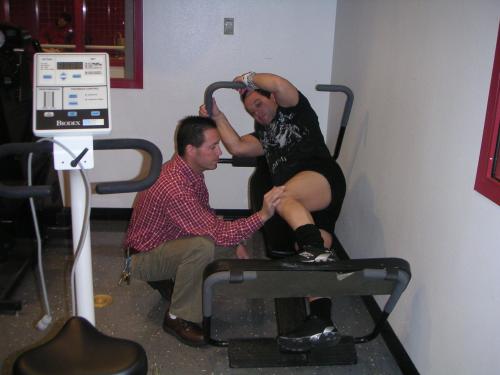TALKING WITH FULLER'S TRAINER

Dave Tomchek, 42, is an athletic trainer for the University of Nevada Las Vegas
(UNLV) men’s basketball program. The seasoned athletic trainer graduated from
the University of
Michigan with a degree in
Kinesiology. He earned his Master’s degree from UNLV in athletic administration
in 1990. Upon graduating, Tomchek was an athletic trainer for the Runnin’ Rebels
from 1990-92. He served as an athletic trainer and director of strength and
conditioning for the Atlanta Braves minor league system from 1992-97. He also
acted as the athletic trainer for the Michael Jordan Senior
Flight School in Las
Vegas the past 10 years and is the director of medical
services for the NBA Summer League. In this Q&A, Rod Fuller’s athletic
trainer provides insight about Fuller’s ACL injury and recovery process as the
Top Fuel star gears up for preseason testing at
Q: When did you meet Rod Fuller?
TOMCHEK: I was contacted by Jeff Motley of Las Vegas Motor Speedway in the late spring/early summer of this year. Rod (Fuller) called me and discussed medical options for his upcoming ACL surgery, comparing the differences between having it done in Las Vegas or by various other specialists in the United States.
Q: When did you first work with Rod?
TOMCHEK: It was right after the race in Reading (Pa.) when his knee locked up before the final round at the rain delay. That’s when I determined that he wasn’t going to make it through the season without implementing a strength and conditioning program for his knee.
Q: When you first met Fuller how serious was the knee injury?
TOMCHEK: Speaking over the phone and discussing the surgery with Dr. Prochaska, we identified that it’s a very common athletic injury. Since surgery wasn’t imminent we had to enhance the strength that Rod had in the knee so he could maintain his lifestyle as a drag racer. We started a weekly routine to develop strength around the knee since he was deficient due to the ACL ligament injury.
Q: Take us through Rod’s knee surgery?
TOMCHEK: The surgery was common in athletics. The one good thing with Rod is that he’s an athlete. He’s very strong and driven to work out in the weight room. It was beneficial for his recovery that he was able to develop and maintain a high level of strength in the muscles that surround the knee. In addition to the ACL he also had medial and lateral meniscus tears. It’s not uncommon, but adds to the severity of the injury.
Q: Take us through the rehab process for Fuller?
TOMCHEK: The surgery, as it stands, has been successful. The concern you have with surgery is that you have to let the body heal. Typically, for this type of surgery you’re looking at a three-four month healing process. In Rod’s situation, we had only two months before he had to get in the car for testing. So, we accelerated his rehab for an increased sense of urgency in range of motion, flexibility and strength.
Q: How is Rod handling the rehab process?
TOMCHEK: The one good thing about Rod is that he’s athletic. He has as much will power and drive as anyone I’ve ever met. He never shies away from doing any exercise that we ask of him. The downside to Rod is that he knows where he has to go and we don’t have the time, so he gets impatient because he wants to be better yesterday. He’s gung ho and wants to do as much as he can. We have to take it slow because the body is still healing.
Injuries like these aren’t common in racing, but they do happen and it’s not just with drivers. The NHRA may need to step up its conditioning program like NASCAR has. They NHRA should have an athletic trainer available at the track. Rod is high profile because he’s a driver, but it could happen to a crew member also. It’s not a typical stick and ball sport, but these injuries can happen and need to be take care of.




































